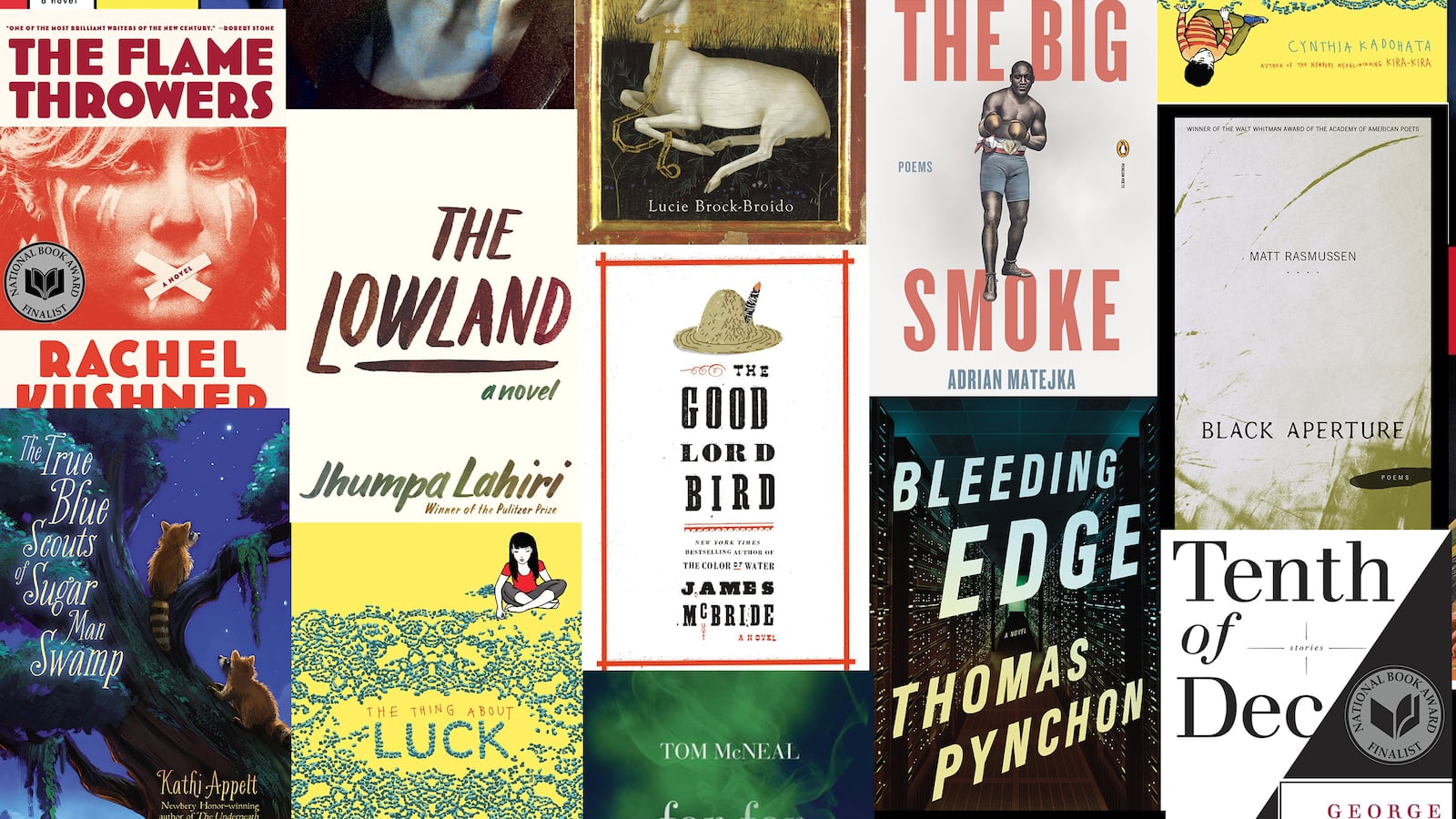You might not be able to tell what a book is about, but on first glance a book jacket will attract or repel you, or (perhaps worse) leave you indifferent. Brian Gresko talks to color expert and design critic Jude Stewart about the covers of the National Book Award Finalists, in order to find out what makes a successful book jacket.

As the first thing you see, the cover is how a book introduces itself, and just like a limp gripped handshake leaves a less-than-perfect first impression, so too can a mishandled book jacket set you against the contents before you’ve even cracked the spine.
How deep does that impression go? The National Book Award Finalists were announced a few weeks ago, and I wondered: could one predict a winner based solely on their jackets? I turned to color expert Jude Stewart for help. Stewart’s new book, ROY G. BIV: An Exceedingly Surprising Book About Color unpacks the secret history of all 7 colors of the rainbow. Well, make that 6, because while Isaac Newton saw the same rainbow we do, harmony was key to the Enlightenment era mind, and so Newton added indigo to the mix to make nature’s colorful arc echo Descartes’s 7 tone musical scale. Stewart’s book also explores other shades—pink, brown and gray among others—not appearing in the traditional rainbow.
Are there colors that might make us feel more favorably toward a book before we even know what it’s about? I asked her. “If there were, then publishers would all be using that color, and there’d be a new opportunity for contrast,” Stewart told me over Skype. “That should be the book designer’s first question—how do I make this cover stand out from the others? What is going to make people pay attention?”
I asked Stewart to examine the National Book Award Finalists by category, looking for trends in cover design, and selecting what she thinks is the most successful of the batch. What follows is her analysis. Might her choices be winning ones? If you’re into placing bets, put your money down now. The award recipients will be announced on November 20th.
FICTION FINALISTS

With the exception of the moody blue on Thomas Pynchon’s Bleeding Edge, most of the colors here are in the same family of black, white, and red. These are very elemental colors, and there’s a linguistic basis for that. In 1969 two linguists, Brent Berlin and Paul Kay, found that color terms nearly always enter languages in the same order. The most basic languages refer only to black and white. If there’s a third term for color in the language, it will always be red.
The cover of Rachel Kushner’s The Flamethrowers has two contrasting shades of red, which is compelling—it captures my eyes. That tomato red always says revolution to me, it’s used a lot in political posters, and of course brings to mind communism. While in our politics red denotes a conservative state, Americans are, as usual, the exception to the rule. In most parts of the world, red is seen as the liberal color and blue conservative.
One of the only universal associations I found in my research was of red connoting blood. James McBride’s The Good Lord Bird has that red line running around the edge, and it made me think about the symbolism of a red thread, which resembles a rivulet of blood. In Japan and China there’s the red string of fate that binds two people who are destined to be together. In Germany, red threads signify a through line to your life, a theme you return to again and again. During the French Revolution, families who lost someone to the guillotine would attend “victims’ balls”, dancing parties where they wrapped red threads around their neck—talk about gallows humor!

I like the subtle palette of Jhumpa Lahiri’s The Lowlands the best. There’s a nuance of shade, and a dense, watercolor style that opens up the contained space of the cover. It feels very intimate. There’s something beautiful in the assonance of the soft name and the subtle colors, and the gradations of relationships between the two brothers in the novel. I like the restraint used in this cover.
If you look at last year’s winner in fiction, Louise Erdrich’s The Round House, you’ll also find a minimal color scheme, which I find very compelling. Erdrich’s cover uses design elements—the strong circular motion around the title, the broken shards with their deep texturing—to lure your eye in, but that design is underlined by the restrained use of color . Personally I’m a fan of gray as a color that beautifully offsets not just other colors, but also other strong design components. I couldn’t agree more with artist Paul Klee: “Gray is the richest color, the one that makes all the others speak.”
NONFICTION FINALISTS

The cover to Lawrence Wright’s Going Clear is puzzling. Yellow stands for life in Scientology, which is a unique association for that color to have, and triangles are significant as well, but if you don’t know that then those symbols come across as confusing. Maybe someone would wonder, “What the hell are these yellow triangles?” and pick up the book out of curiosity, but I don’t find it an intriguing enough design to prompt that response.
Cover designers always have to consider what else is out there on the shelves, but sometimes they don’t want their books to stand out so much as blend in. Wendy Lower’s Hitler’s Furies looks like any number of World War II history books, which is telling us, “This book is just as serious as all those others even though it’s about a topic—Nazi women—that you might not have considered before.”

What I like the most in this category is Jill Lepore’s Book of Ages. It’s a book of letters between Ben Franklin and his sister, Jane. The yellow in the background made me think of Charlotte Perkins Gilman’s short story “The Yellow Wallpaper,” about a 19th century woman who goes mad in an unrelentingly cheerful room done all in yellow. These two women are separated by more than a century, but both must’ve understood confinement. Jane Franklin bore twelve kids, and her life must have been so much more constrained than her brother’s. Of course, that’s knowledge I bring to this cover, but that’s how color works, it’s associative.
That’s a nice resonance in how the red of the woman’s lips match that of the subtitle—“The Life and Opinions of Jane Franklin.” This makes me think of both femininity and her voice. And while the blue in the upper right corner literally implies the sky; next to her head like that, it also seems like the space of her thought. This cover works very well.
It’s uncanny how many similarities exist between the book cover of last year’s nonfiction winner, Katherine Boo’s Behind the Beautiful Forevers: Life, Death, and Hope in a Mumbai Undercity, and Lepore’s book, which I’m flagging as a front-runner for this year. Both play within a relatively constrained color palette rich in sepia yellow, with strategic daubs of sky blue and red. Both take as their subject and focus people whose lives are similarly constrained. With a book about Jane Franklin and her life of letters to her brother Benjamin, sepia yellow connotes yellowing papers. In Boo’s book cover, that same yellow takes on different connotations: yellowed smog, perhaps, or the relatively undocumented lives of an unlettered and disadvantaged population. But both covers are stunning, elevating their subjects with a classic, handsome visual treatment rich in texture and detail.
POETRY FINALISTS

There are two covers here that feature famous pictures. On Lucie Brock-Broido’s Stay, Illusion, you see the white hart from The Wilton Diptych. This was the emblem of King Richard II, who was saved from killing a white deer, which in British legend is terribly bad luck. Mary Szybist’s Incarnadine reuses Botticelli’s The Annunciation. Both made me think of the material history of color.
Today, because we use synthetic dyes, everything comes in vibrant shades that are quite cheap to produce. We don’t consider how brilliant color used to come at great cost. The blue in The Annunciation is most likely ultramarine, a pigment made from ground-down lapis lazuli rocks, which had to be hauled across enormous trade routes from Afghanistan. The gold of The Wilton Diptych is actual gold leaf, applied right on the painting. A person who saw these paintings at the time of their creation would not only see the beauty of the artwork, but the wealth of the commissioner. Artist’s contracts used to stipulate not just the subject of the artwork, but the ingredients that the artist would use, sometimes dictating they go with the more expensive pigments. The patrons wanted paintings that showed off how rich they were!
Matt Rasmussen’s Black Aperture looks a lot like other poetry books out on the market. The artist Odilon Redon said, “One must respect black, nothing prostitutes it.” Black is forward, bold, and very strong. In Arthurian legend, a knights wearing black indicate both power but also mystery and independence. A black knight serves no master. In cultures that lack water, black sometimes indicates fecundity, because after a rain soil becomes rich and black. If the cover of Black Aperture made a more daring use of black it would have earned my respect. As it is, I feel only a vague sense of sadness.

Frank Bidart’s Metaphysical Dog is my favorite of this group, especially the subtle gradation of the orange, which resembles a sunset. (Incidentally, a beautifully colored sunset is an indication of how much pollution is in the air. It’s a result of the sunlight bouncing off particulate matter in the atmosphere. The worse the air quality, the better looking the sunset.) I’m not sure what the image is, exactly. I know it’s crumpled paper but it transmogrifies into sculpted smoke. I want to touch it, there’s an implication of texture. Like The Lowlands, it opens up the space of the cover and draws you into its intimate space.
Of course, perhaps the boldness of Bidart’s cover will alienate the judges. Last year’s poetry winner, David Ferry’s Bewilderment, features a bland cover design that aims less to draw the eye than not to offend it with any wild visual swerves. I’m cool on Ferry’s cover design: Bewilderment is a strong, provocative title, but this cover is anything but. Frankly I’m finding myself bewildered into boredom by the missed opportunity this cover represents.
YOUNG PEOPLE‘S LITERATURE

The green on the cover of Tom McNeal’s Far, Far Away is eye-catching, but overall the cover’s design signals that this book is going to function in a certain way—if you like magic, witches, and adventure stories, then this is for you. The cover does its work, but it’s a little too functional for me.
I see some uncanny echoes between last year’s winner, William Alexander’s Goblin Secrets, and Far Far Away. Both are literally depictions of magical air, evocative of movement and potency stirring inside a writhing cloud. Goblin Secrets’ most notable colors—beyond the sepia tints dominating the cover—are red and blue, a pair of classic color opponents if ever there was one. Cognitive scientists love pitting red against blue in experiment after experiment, teasing out the psychological effects of each color. For example, red rooms make people working in them more accurate and cautious, and blue turns them more creatively loose—so claims a 2009 study in the journal Science. Other findings: Teams in red Olympic uniforms enjoy a statistically significant edge over those clad in blue, while red test covers on IQ tests can make us antsy enough to drag down scores.
Cynthia Kadohata’s The Thing About Luck is my favorite here. Yellow shares some symbolic meanings across China and Japan. The Chinese Emperor Huang Ti was called the Yellow Emperor because he clothed himself all in yellow to worship the sun. According to legend, he invented wooden carts, the bow and arrow, and writing. Because of that association, pencils are often painted yellow. When a huge graphite lode was discovered in Siberia in 1847, Chinese pencils flooded the world market, which is why our pencils are yellow today.
I also like the turquoise blue color of the chips or beads that the kids are stringing together into that intricate design. It brings to mind jade. Confucius, an important figure in both China and Japan, said that there were 10 virtues to Jade, which has lead to a fortune cookie saying that “Gold is valuable, but jade is invaluable.” The Thing About Luck sounds like a book full of sorrow, but the cover is beautiful and bright, and that contrast is compelling.






